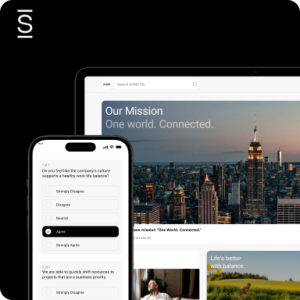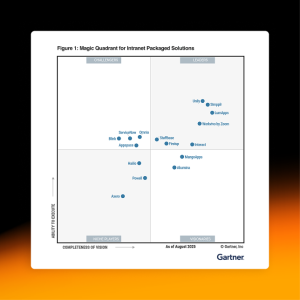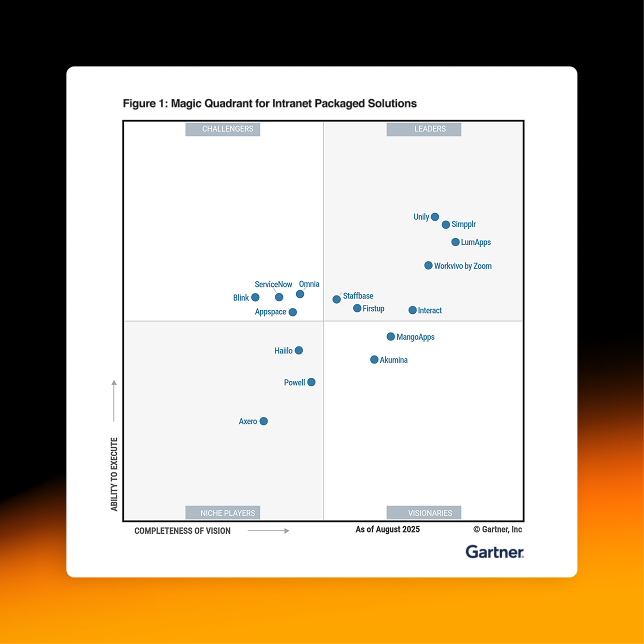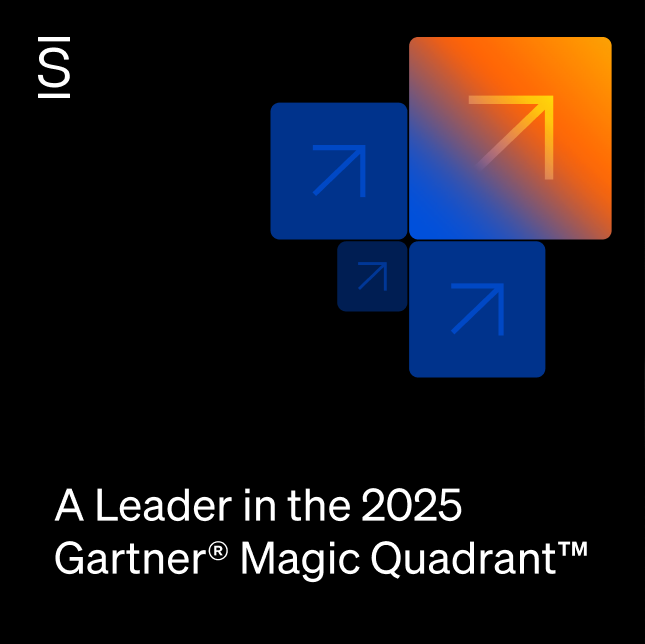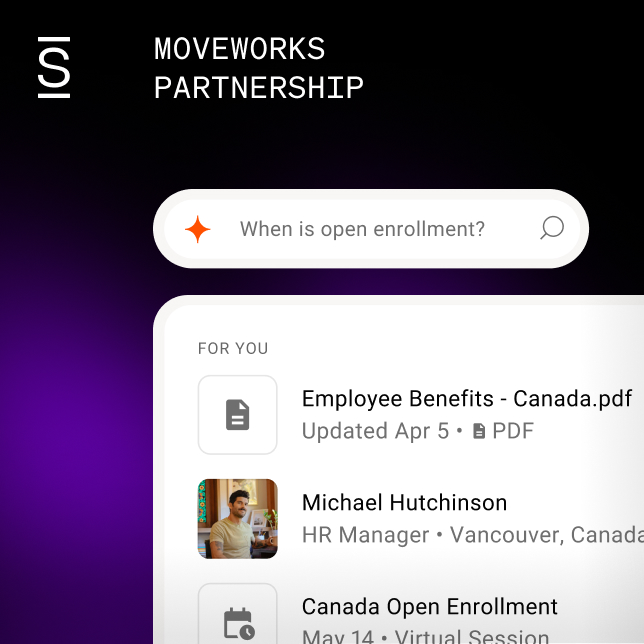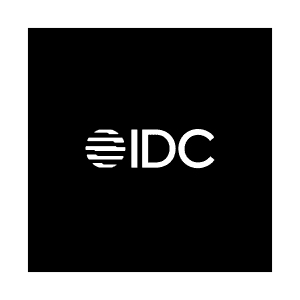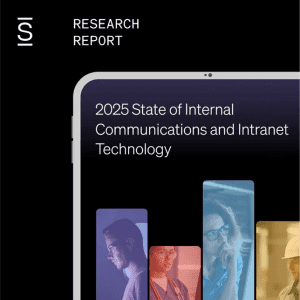Regardless of the industry, organizations face the challenge of keeping employees engaged, informed, and productive in the workplace. That’s why finding the best intranet platform has become a business-critical decision that determines whether your employees have everything they need to thrive on the job.
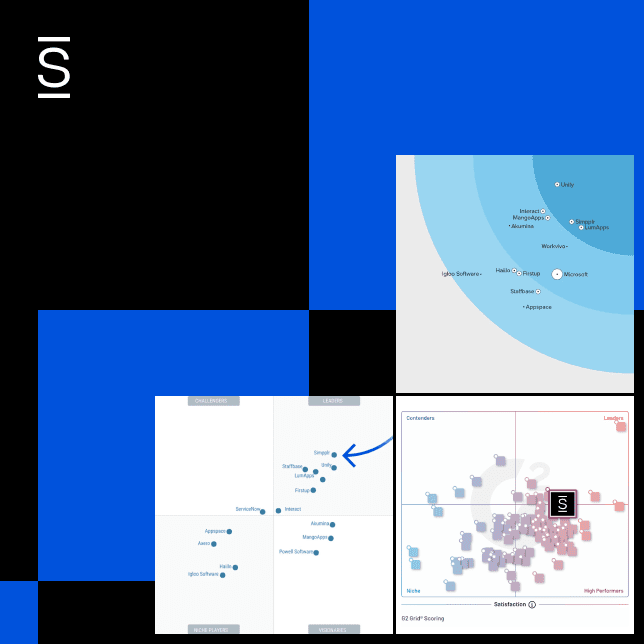
The best intranet software and platforms: 2025 guide
Employee engagement in the U.S. has fallen to its lowest since 2014, according to Gallup’s State of the Global Workplace: 2025 Report. Only 31% of employees are engaged at work, and 17% are actively disengaged. This trend can impact productivity, satisfaction, and retention.
Today’s workforce expects easy access to information, a dedicated space to collaborate, and recognition for their contributions. They want their voices heard, their opinions valued, and transparency from leadership. That’s why finding the best intranet platform has become business-critical.
As a knowledge center, the employee intranet provides a single source of truth for information, resources, and people. As a collaboration platform, it unifies teams for better outcomes on projects. And as a communications channel, it promotes employee connection and commitment to the organization.
How do you choose the best intranet platform? This article explores the top-rated intranet platforms according to leading industry analysts to help you identify which platform best serves your organization’s unique needs and long-term goals.
Choosing the best intranet platform using analyst reports
Let’s drill into review methodology. We used authoritative analyst and user-review reports to compare the best intranet platforms. The reports are:
- 2024 Gartner® Magic Quadrant™ for Intranet Packaged Solutions
- The Forrester Wave™: Intranet Platforms, Q2 2024
- G2 Grid® Report for Employee Intranet, Summer 2025
- IDC MarketScape: Worldwide Employee Experience for Integrated Employee Workspaces 2025
Key criteria and requirements for intranet platform selection
The Gartner® Magic Quadrant™ for Intranet Packaged Solutions (IPS) is a research methodology and graphical representation that provides an analysis of a market’s direction, maturity, and participants on completeness of vision and the ability to execute that vision.
The report specifies key criteria and requirements for cohesive, cloud-based products specifically designed for intranet use cases. Solutions must include content services, integration capabilities, personalization, analytics, workflow automation, a common UI framework, multiexperience support, and security and access management. Offerings that relied on additional platforms or lacked these essential features were excluded.
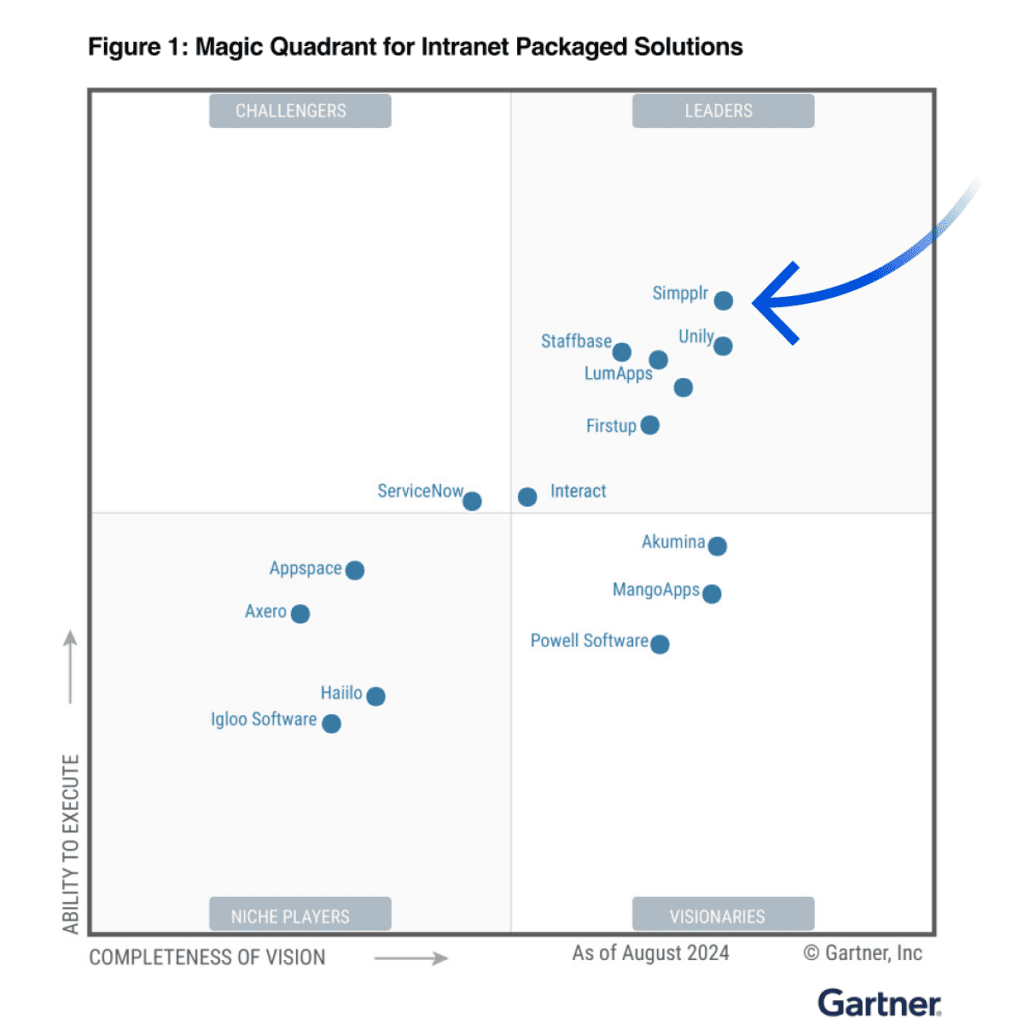
The Forrester Wave™: Intranet Platforms, Q2 2024 report offers a consistent methodology and transparent scoring across two axes: strategy and strength of current offering. The report includes only cloud-first intranet platforms with a minimum annual product revenue of $10M, marketed as solutions for intranet and employee communications, scalable to 5,000+ employees, and with active interest among Forrester clients.
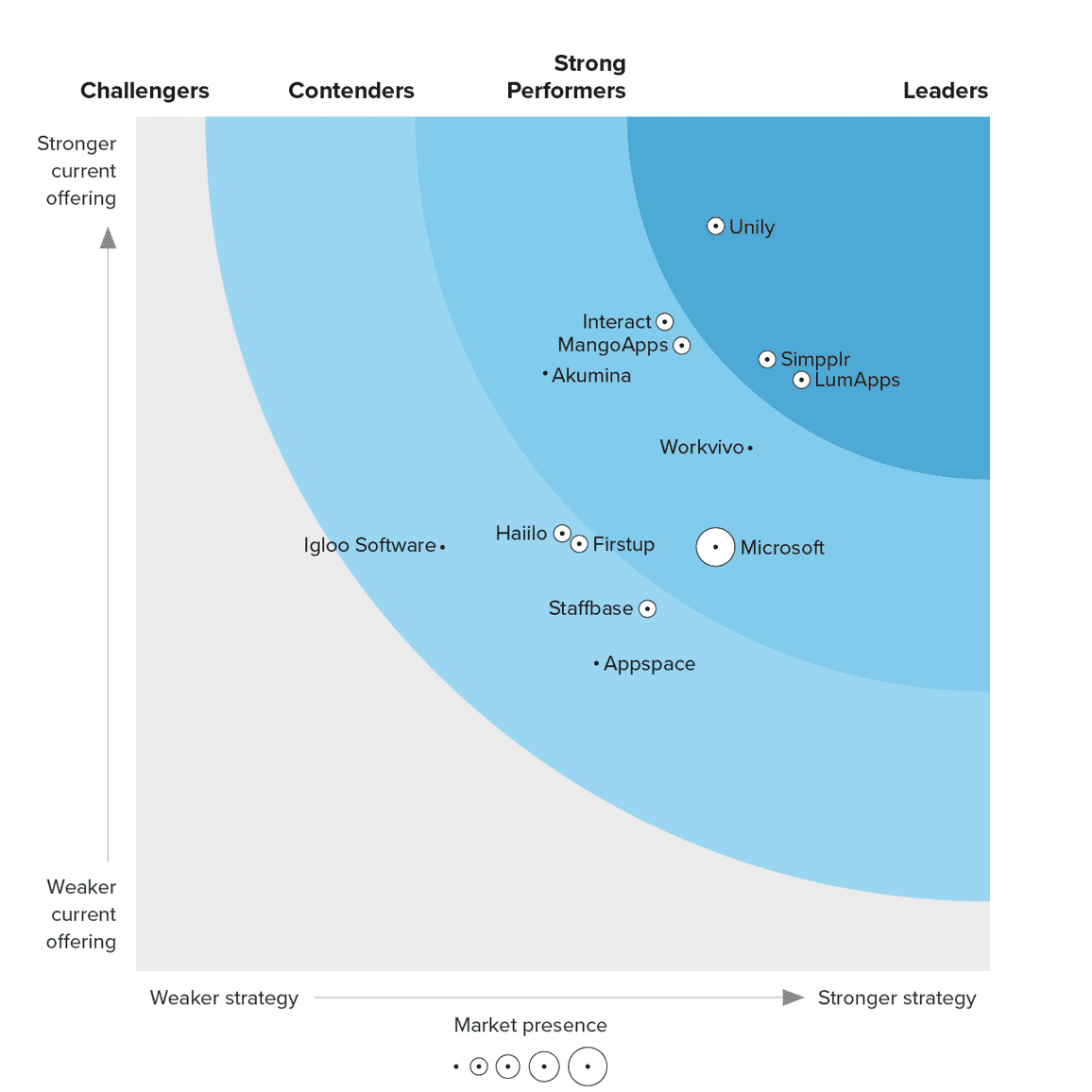
The G2 Grid® Report for Employee Intranet, Summer 2025 is based on a snapshot of verified user reviews. Because G2 allows products to appear in multiple categories, the grid for “Employee Intranet” includes everything from purpose-built intranets and packaged solutions to point solutions and tools in tertiary categories — some of which cover only specific intranet use cases rather than the full experience.
The IDC MarketScape: Worldwide Employee Experience for Integrated Employee Workspaces 2025 Vendor Assessment serves as a buyer’s guide that evaluates providers and selection criteria for the integrated employee workspace market. Its methodology assesses AI readiness, customer satisfaction, platform extensibility, and long-term strategic vision. Inclusion is limited to vendors that consolidate employee touchpoints, integrate with existing technology stacks, and provide a foundation for AI-powered personalization and automation.
IDC describes Integrated Employee Workspaces (IEWs) as modern digital hubs that bring together information, applications, and communications into a single, seamless experience.
IEWs provide a unified framework that brings together capabilities often spread across multiple systems, while giving organizations the flexibility to design a digital workplace that reflects their unique culture and workflows.
IDC highlights solutions that unify analytics, workflows, and integrations into a single platform, giving employees a consistent experience whether they’re in the office, remote, or on the frontline. By doing so, IEWs emerge as a modern alternative to the fragmented systems and static intranets of the past.
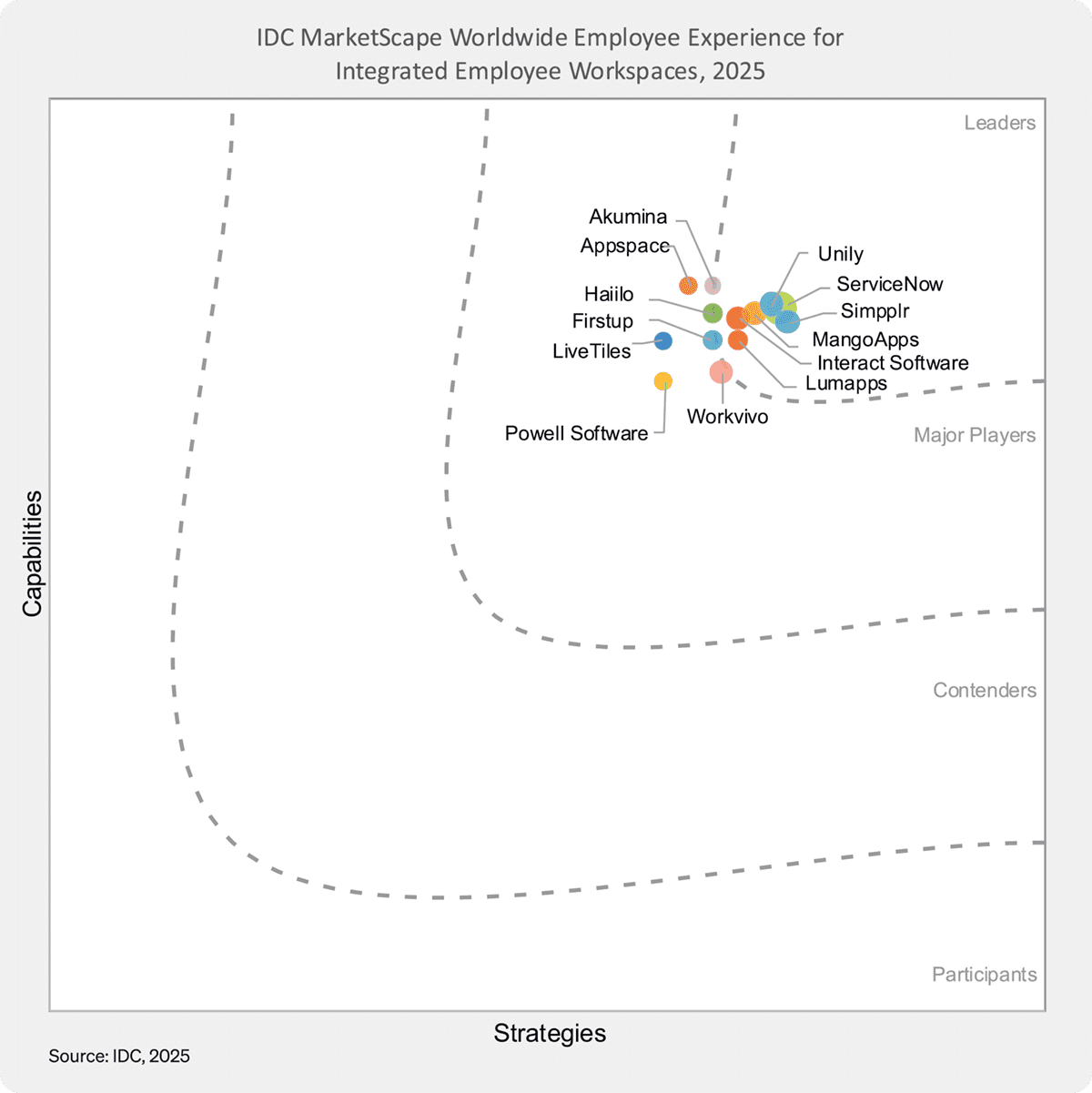
Guidelines to select the ideal intranet software
The best intranet software should be considered a leader by both independent evaluators with strict methodologies and G2, which gathers real-world user ratings.
Top 10 intranet platforms and solution providers
There are diverse solutions in the market, but the right modern intranet centralizes and streamlines all essential company information. It also extends into other organizational use cases to improve productivity and the overall employee experience.
Here are the top ten intranet platforms based on independent analyst reports and user reviews:
- Simpplr
- Unily
- Workvivo
- LumApps
- Staffbase
- Interact
- Igloo
- Hailio
- MangoApps
- Firstup
1. Simpplr: #1 intranet platform
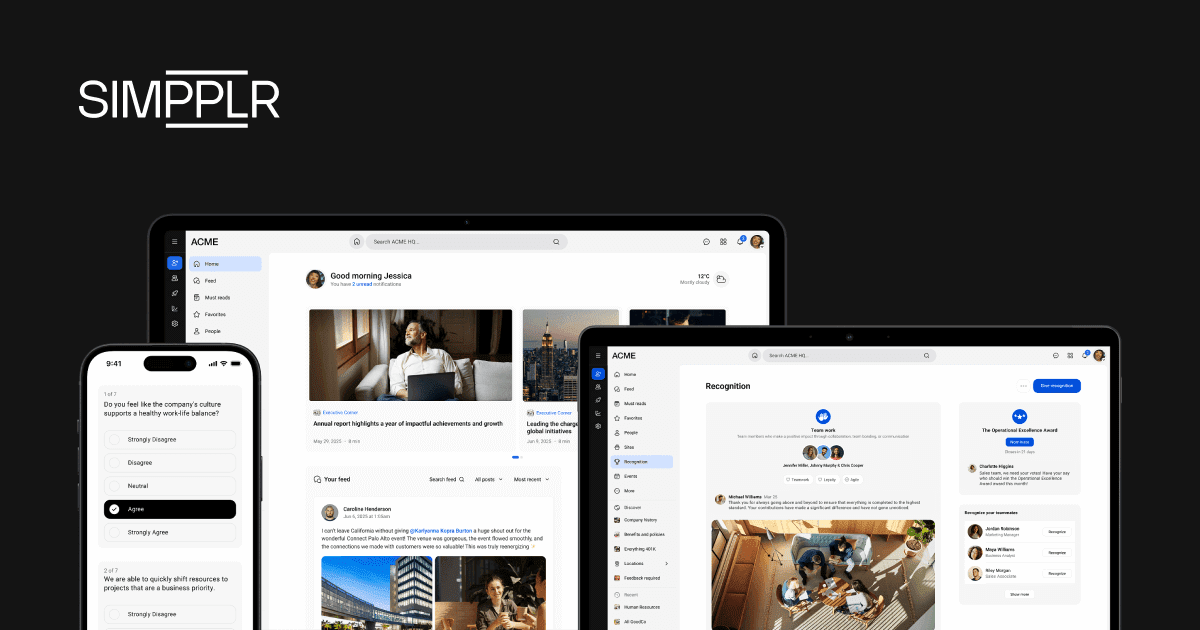
Simpplr per Gartner Magic Quadrant
Simpplr is named a Leader among the 15 vendors in the 2024 Gartner Magic Quadrant for Intranet Packaged Solutions, demonstrating strength in both “completeness of vision” and “ability to execute.” The report highlights that “it offers a comprehensive intranet experience out of the box for desk, frontline and contingent workers, encompassing social, communication, collaboration, and knowledge management tools.”
Simpplr’s key strengths include:
- Strong out-of-the-box functionality that enables rapid deployment and reduced reliance on IT
- High customer satisfaction with search, content governance, and ease of use
- Excellence in delivering a unified, personalized employee experience across all roles
Simpplr’s dedication to enterprise-grade support for customers around the world was recently honored by a 2025 Stevie Award for Sales and Customer Service for success in transforming its global support operations.

Simpplr per The Forrester Wave
The Forrester Wave: Intranet Platforms, Q2 2024 recognized Simpplr as a Leader in strategy and offering. Forrester scored Simpplr the highest in AI and machine learning, surpassing competitors like Unily, LumApps, Workvivo, Staffbase, MangoApps, and others.
The platform has “strong AI/ML capabilities that facilitate deep personalization of an employee’s news feeds based on role, topic, or other context to deliver relevant information.”
Simpplr received 5 out of 5 for adoption and innovation — highest among Leaders — showcasing its impact on employee experience. Users see “Simpplr’s internal communication tools as a ‘strong suite’. They like its content authoring capabilities, reporting, and application integration.”
Simpplr per G2 Grid
In G2, only 10 of the intranet contenders appear in the Leader quadrant, meaning they’re strong in both user satisfaction and market presence. While Microsoft SharePoint is at the top right of the grid, placement is more representative of market share. SharePoint is used most often for building a custom intranet rather than buying all-in-one intranet software. Simpplr’s ratings lead SharePoint across all four of the user satisfaction categories reported.
Simpplr received overall user ratings for:
- Quality of support: 94%
- Ease of use: 95%
- Being a good partner in doing business: 95%
- Ease of administration: 91%
By comparison, SharePoint received scores of 7.9 for quality of support, 7.7 for ease of use, 8.2 for being a good business partner, and 7.5 for ease of admin.
Simpplr per IDC MarketScape
Simpplr has been named a Leader in the IDC MarketScape for Integrated Employee Workspaces 2025 Vendor Assessment.
The AI-powered intranet platform is designed to unify internal communications, engagement, and service delivery in one simplified workspace. The report noted that “Simpplr’s native AI includes GenAI to help companies deliver personalized answers and content, automated workflows, and make search capabilities more intuitive.” This AI framework powers enterprise search and insights across both native features and integrated systems.
Unlike vendors that are either too comms-focused, too architecture-heavy, or too service-driven, Simpplr balances usability, adoption, and advanced AI orchestration in one platform.
Simpplr’s strengths included:
- Highly praised customer support and partnership style
- Strong AI personalization, search, and analytics
- Intuitive, streamlined design with high adoption
- Helps clients frame AI orchestration beyond comms
Simpplr’s low-code and no-code extensibility enables IT teams to easily scale digital solutions. Custom app tiles, APIs, and out-of-the-box connectors create a single interface where employees can find everything they need. The platform is often cited by customers for the strength of its customer support teams and customer enablement.
“Simpplr customers expressed high levels of satisfaction with the competency of the platform’s AI features, including personalization support and intelligent search, and that the platform’s analytics supported an always on feed of quarriable and actionable insights.” — Zachary Chertok, Senior Research Manager, Employee Experience, IDC

Best for: Midsize and enterprise organizations looking to modernize their intranets and bring communications and resources into one place. A strong choice for distributed teams, highly regulated industries, and companies preparing to take advantage of AI-driven orchestration.
Simpplr customer testimonials
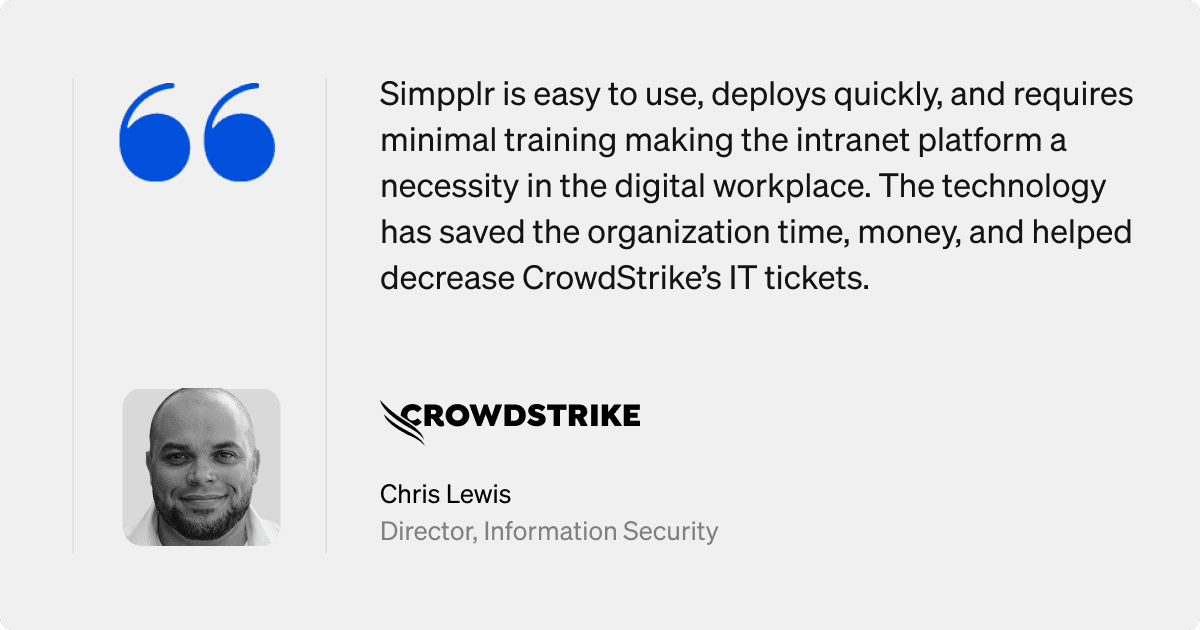
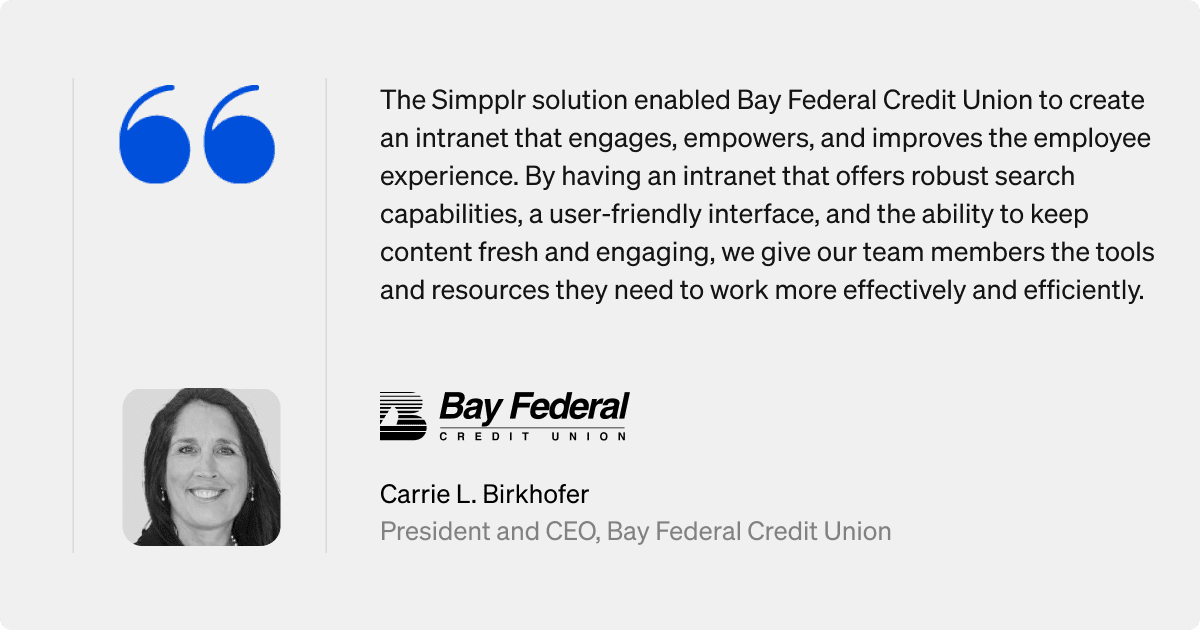
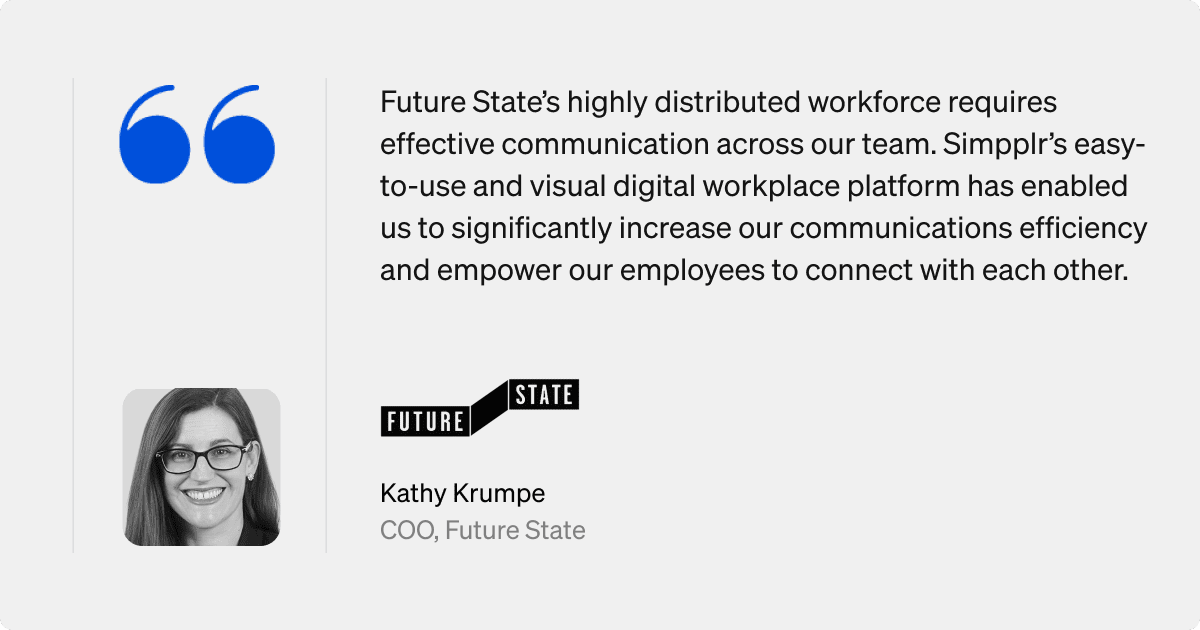
2. Unily
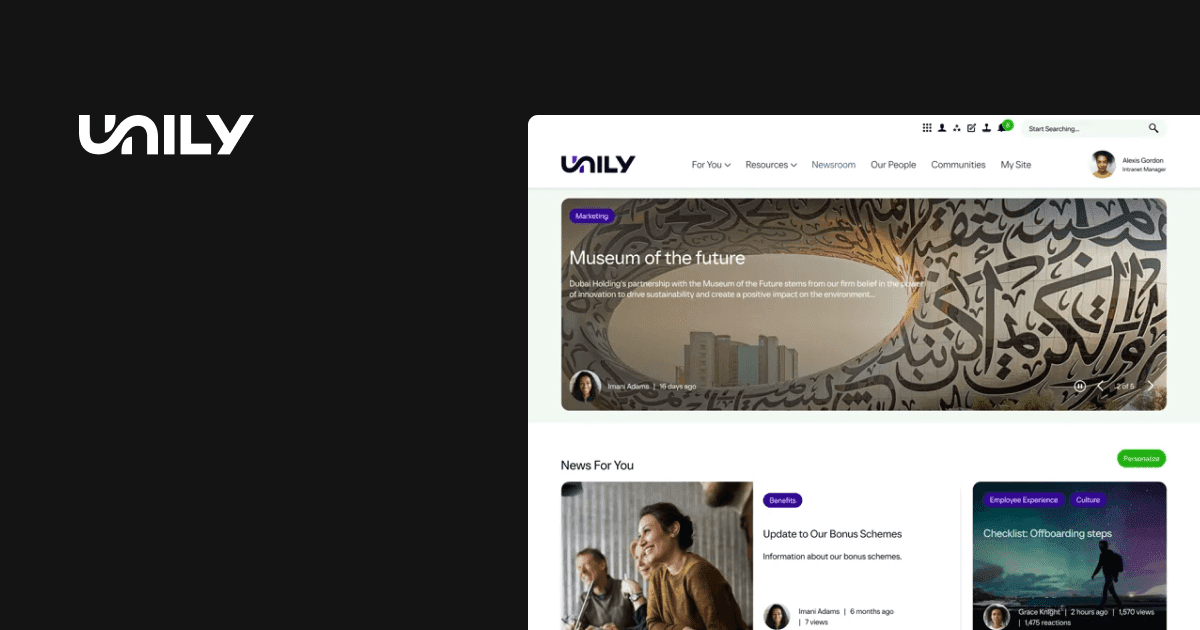
Unily per Gartner Magic Quadrant
Unily was named a Leader in the 2024 Gartner Magic Quadrant for IPS. The report noted that “Unily was created to unify heterogeneous environments that have complex criteria for technology enablement,” making it a popular choice for organizations with complex intranet requirements.
Unily’s key strengths include:
- Comprehensive content management and personalization capabilities
- Supports large-scale deployments with robust operational configurations
- Strong external knowledge and community platform, “Universe”
While Unily has many out-of-the-box integrations, Gartner analysts caution that its chosen technology might not match up with organizations’ existing front-end structures. According to the Gartner Magic Quadrant 2024 report, “Unily relies on the Angular Module Federation framework, which may run counter to existing front-end architecture standards,” potentially causing a conflict in development options.
Unily per The Forrester Wave
Unily is a Leader in The Forrester Wave: Intranet Platforms, Q2 2024. Launched initially as a SharePoint add-on, Unily has evolved into a robust cloud-native intranet and internal communication platform for global enterprises.
According to the report, Unily is flexible and strongly focuses on automation “in areas like content governance, repeatable employee journeys, and communication campaigns.” Its easy-to-use workplace tools contribute to customers’ success but show weakness in “native collaboration that supports communities and frontline worker coordination.” The 2024 Forrester Wave report went on to caution that customers have raised “some concern about extra costs for new features.”
Unily per G2 Grid
Among G2 reviewers, Unily didn’t rank in the top quadrant. In G2’s four user satisfaction categories, Unily’s overall ratings trailed behind Simpplr’s in every area — except for ease of use, where it scored the same percentage:
- Quality of support: 88%
- Ease of use: 95%
- Ease of doing business with: 86%
- Ease of administration: 86%
Unily per IDC MarketScape
Unily was also named a Leader in the IDC MarketScape: Worldwide Employee Experience for Integrated Employee Workspaces 2025 Vendor Assessment.
Best for: Large enterprises (10,000 or more employees), with an ideal customer profile of those with 50,000 or more employees.
3. Workvivo
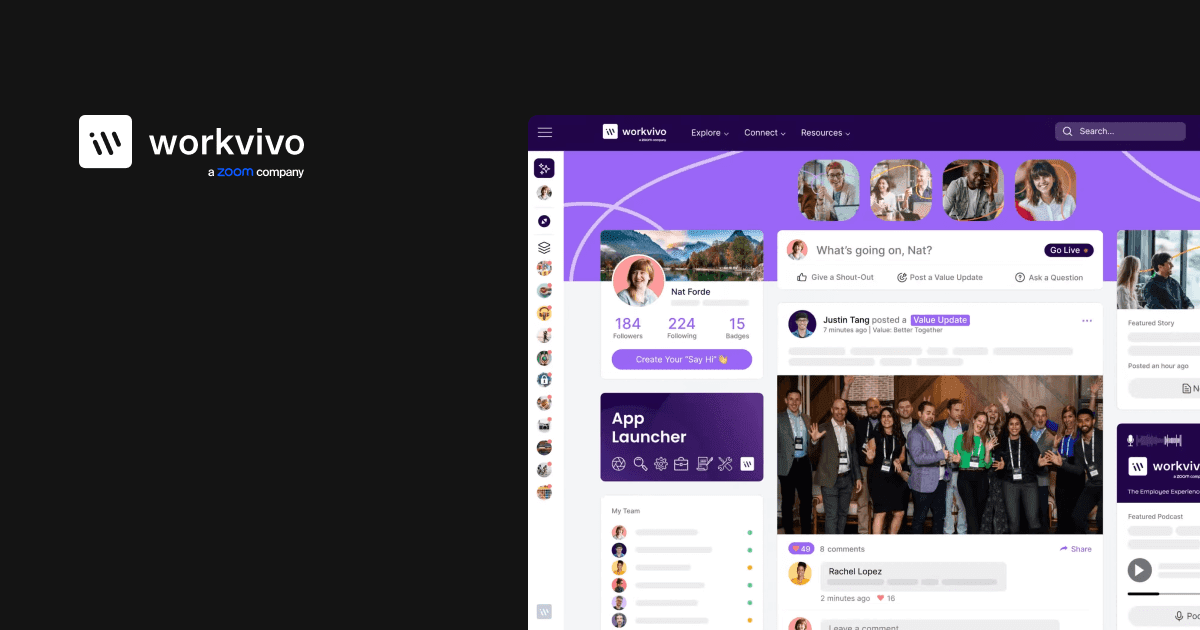
Workvivo per Gartner Magic Quadrant
Workvivo by Zoom is a Leader in the 2024 Gartner Magic Quadrant for IPS. The report highlights that “Workvivo’s leverage of Zoom technology expands the value proposition of its IPS, providing sales and marketing efforts that differentiate it from competitors.” The platform has an “employee engagement model centered on a social and multichannel communication experience.”
Key strengths include:
- Strong community and employee communication capabilities enhanced by Zoom integration
- Expanded market presence due to strategic partnerships like Meta’s Workplace migration
- Innovation in offering real-time communication tools for town halls and events
According to the Gartner report, however, “Workvivo’s emphasis on social, community, and multichannel communication may not convince decision makers seeking a pragmatic business case for integrating the intranet into daily work routines.” Workvivo is largely present in North America and Europe, so “organizations in regions where Workvivo has less adoption may prefer to assess other options.”
Workvivo per The Forrester Wave
Workvivo is a Strong Performer in The Forrester Wave: Intranet Platforms, Q2 2024. Within the evaluation criteria, the Forrester Wave recognized Workivivo’s “strong native collaboration tools such as communities, support for employee-generated content, and 1:1 and group messaging, which can extend to frontline workers.”
However, the Forrester report noted that Workvivo “faces the challenge of balancing its priorities, such as expanding integration for clients in the Microsoft 365 ecosystem, while capitalizing on new bundling opportunities across the Zoom portfolio.” Forrester cited customer dissatisfaction with Workvivo’s “workflow automation, such as journeys and the breadth of developer tools.”
Workvivo per G2 Grid
Workvivo was included in the top quadrant of the G2 report with high user ratings:
- Quality of support: 97%
- Ease of use: 96%
- Ease of doing business with: 98%
- Ease of administration: 97%
Workvivo per IDC MarketScape
Workvivo was named a Major Player in the IDC MarketScape: Worldwide Employee Experience for Integrated Employee Workspaces 2025 Vendor Assessment based on a wide range of current capabilities and offerings.
Best for: Organizations that want to focus on social, community, and multichannel communication in their daily intranet routine.
4. LumApps
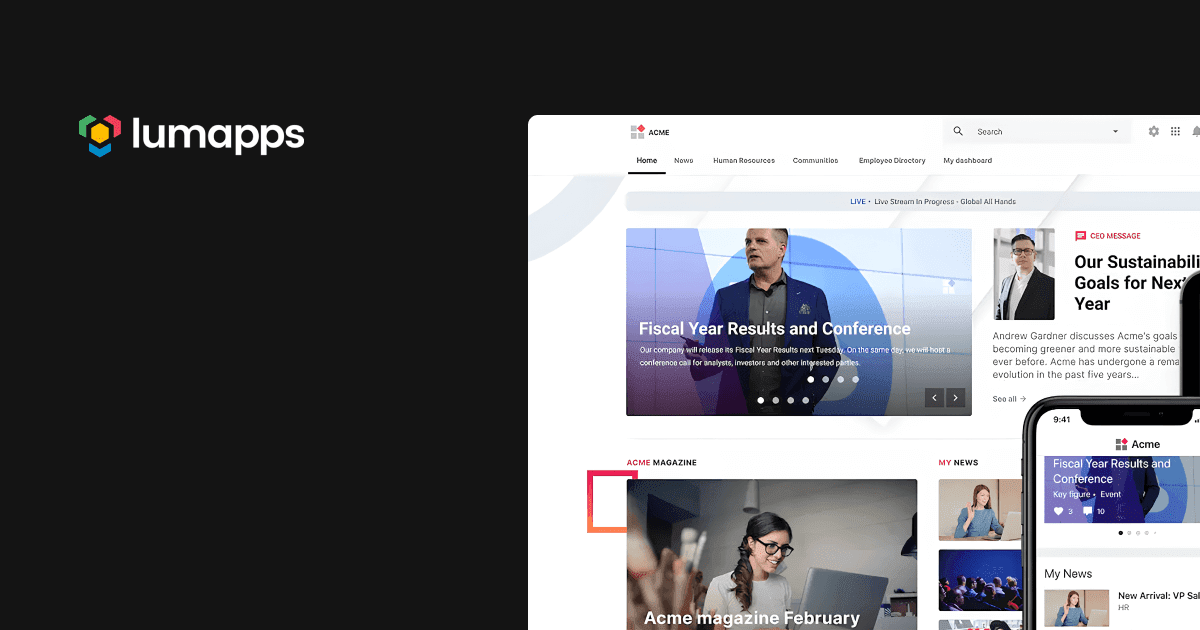
LumApps per Gartner Magic Quadrant
LumApps was named a Leader in the 2024 Gartner Magic Quadrant for IPS. The platform focuses on communications, employee engagement, collaboration, culture, and knowledge sharing. Capabilities include facilities for communications campaigns, journey management, and native video management.
Key strengths include:
- Strong multichannel communication capabilities with AI enhancements
- Extensive integration portfolio with over 100 connectors to major enterprise platforms
- “Companion” app for frontline and desk workers
Despite LumApps’ strong vertical product offerings, Gartner analysts identified a gap: “Customers might want more sector-specific expertise and less dependence on partners…organizations may find microapps too shallow to help guide them in solving the vertical needs of their intranet, thus, look for a vendor with more hands-on experience.”
Users seeking out-of-the-box simplicity may also prefer alternatives, as “some customers report requiring greater-than-expected development, deployment, and design effort when using LumApps.”
LumApps per The Forrester Wave
LumApps was positioned a Leader alongside Simpplr and Unily in The Forrester Wave: Intranet Platforms, Q2 2024. Originally focused on the Google ecosystem, LumApps integrates with Microsoft 365 as well. The report notes that “LumApps has strong capabilities including reporting, application integration, metadata, search, and workflow-driven employee journeys.” However, the platform shows limitations in survey functionality. The report went on to highlight that “it lags in survey capabilities, which offers basic user feedback and voting.” Customers reported less satisfaction, “with an ‘overwhelming’ pace of new-feature rollout and add-on costs.”
LumApps per G2 Grid
LumApps didn’t make the top quadrant, and its user ratings fell below industry averages in every category:
- Quality of support: 83%
- Ease of use: 85%
- Ease of doing business with: 90%
- Ease of administration: 85%
LumApps per IDC MarketScape
LumApps was named a Leader in the IDC MarketScape: Worldwide Employee Experience for Integrated Employee Workspaces 2025 Vendor Assessment
Best for: Large and midmarket companies with more than 2,000 employees that thrive in the Google or Microsoft ecosystems — or a mix of both.
5. Staffbase
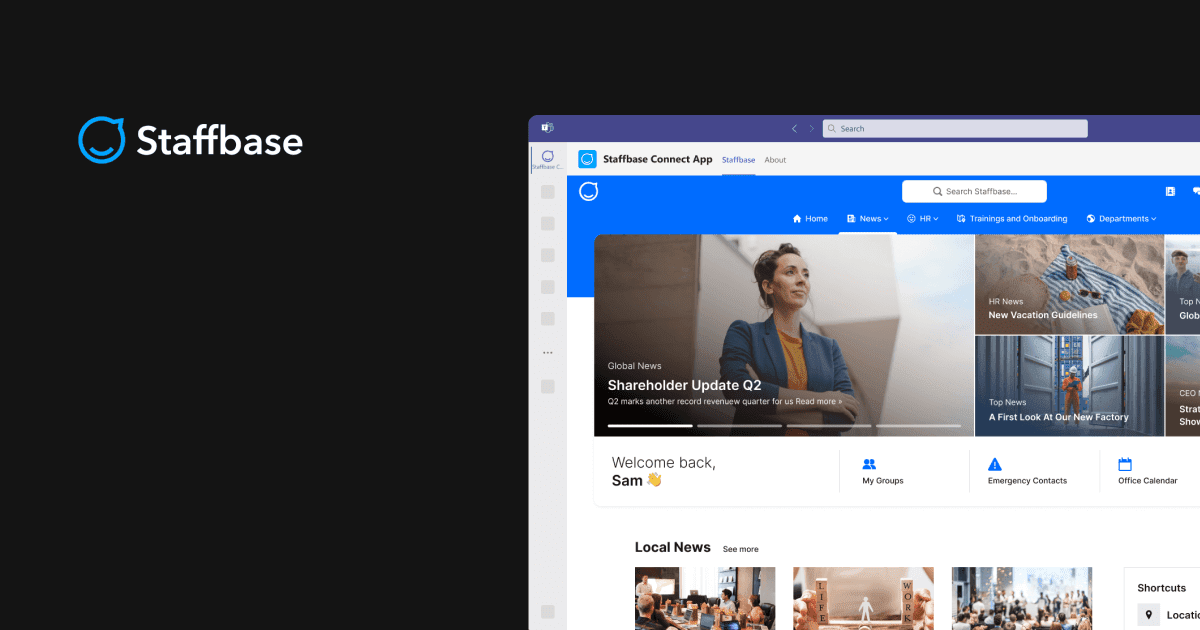
Staffbase per Gartner Magic Quadrant
Staffbase is a Leader in the 2024 Gartner Magic Quadrant for IPS. The platform features an employee app designed for mobile and frontline use, an employee newsletter, and packaged integrations for Microsoft 365. Gartner analysts highlight its “ongoing change and transformation in manufacturing, energy and utilities, automotive, transportation, logistics, healthcare, retail, and finance and consulting.”
Key strengths include:
- Focus on employee communications and integration with Microsoft tools
- Unified solution for desktop and mobile users with excellent administrative features
- New metrics and dashboards to measure intranet performance
Gartner cautions that Staffbase’s analytics, notifications, and search functionalities require improvement, as “customers indicated not being able to find information and documents on the intranet.” Gartner also noted that Staffbase’s regional focus is predominantly in Europe with limited data sovereignty support in other regions.
Staffbase per The Forrester Wave
Staffbase named a Contender in The Forrester Wave: Intranet Platforms, Q2 2024. The report noted that “Staffbase excels in internal communication features, such as calendaring, audience segmentation, SMS support, and editing tools for email newsletters.
While Staffbase received praise for its internal communication features, concerns were raised about gaps in core intranet functionalities, including “limited content governance capabilities, options for content approval workflows, native file and media management tools, as well as reporting on content freshness.”
Staffbase per G2 Grid
Staffbase appeared in the Leader quadrant of the G2 report with strong user satisfaction ratings:
- Quality of support: 95%
- Ease of use: 94%
- Ease of doing business with: 97%
- Ease of administration: 93%
Staffbase per IDC MarketScape
Staffbase isn’t included in the IDC MarketScape: Worldwide Employee Experience for Integrated Employee Workspaces 2025 Vendor Assessment.
Best for: Multinational organizations looking for a complementary IPS that focuses on employee communications.
6. Interact
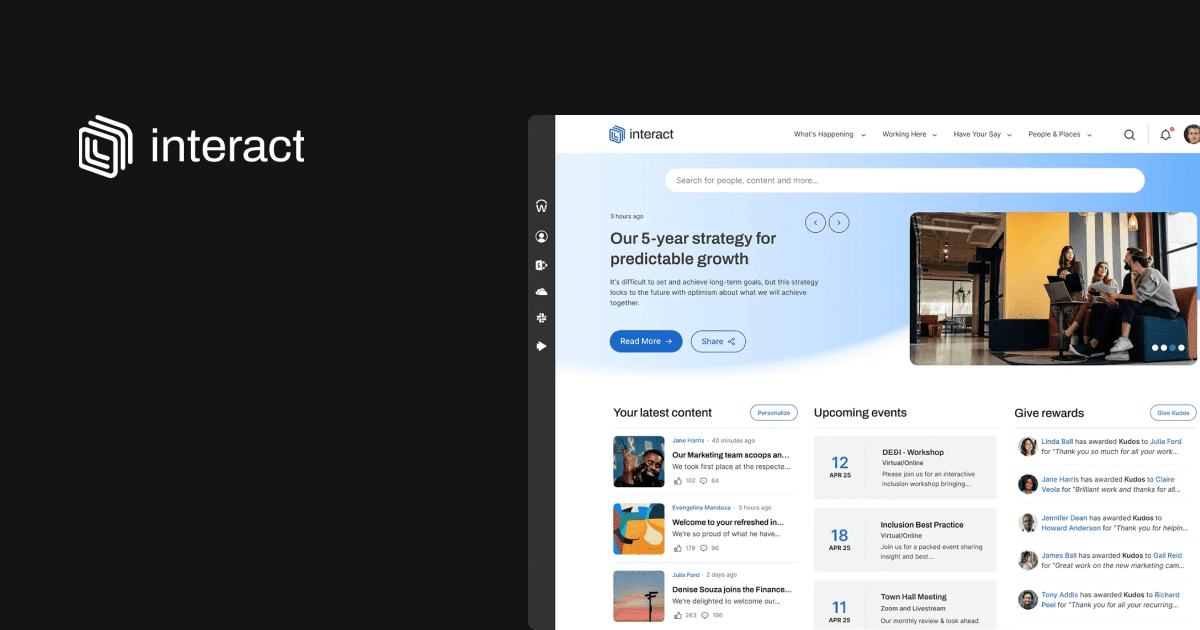
Interact per Gartner Magic Quadrant
Interact is named a Leader in the 2024 Gartner Magic Quadrant for IPS. Gartner analysts note that “Interact has a good understanding of the IPS market and its specialized industries. It effectively grasps a buyer’s needs for its workforce, including frontline staff, and collaborates well with organizations to customize its solutions.” Interact’s deep understanding of client needs and investments in GenAI enhance its appeal, especially in verticals like healthcare and financial services.
Interact’s key strengths include:
- Deep understanding of customer goals during sales and deployment phases
- Strong presence in specific verticals like financial services and healthcare
- Continued innovation with GenAI-driven employee experience enhancements
Unlike Simpplr, which combines out-of-the-box connectors with extensibility through app tiles and APIs, Interact requires custom development to integrate with other enterprise systems. Because it focuses on specific verticals, “potential clients should question Interact how it can support their intranet use cases that fall outside of the vendor’s preferred verticals.”
Compare Simpplr vs Interact with key insights from Forrester and Gartner.
Interact per The Forrester Wave
Interact is a Strong Performer in The Forrester Wave: Intranet Platforms, Q2 2024. According to Forrester, “Interact has rich capabilities and adoption services but must raise brand recognition.”
While Interact earned high marks for its content authoring tools, search, and professional services, reference customers were “less satisfied with the reporting capabilities and complexity of some UIs and administrative interfaces. The platform’s “lack of support for complex process-driven employee journeys or multistage campaigns” requires improvements.
Interact per G2 Grid
G2 identified Interact as a High Performer in the report. The platform scored satisfactory across all four user-satisfaction categories, but scored relatively lower in “ease of administration.”
- Quality of support: 91%
- Ease of use: 92%
- Ease of doing business with: 92%
- Ease of administration: 85%
Interact per IDC MarketScape
Interact Software was named a Leader in the IDC MarketScape: Worldwide Employee Experience for Integrated Employee Workspace 2025 Vendor Assessment
Best for: Organizations specializing in financial services, retail, healthcare, and pharmaceutical verticals looking for an intranet platform.
7. Igloo
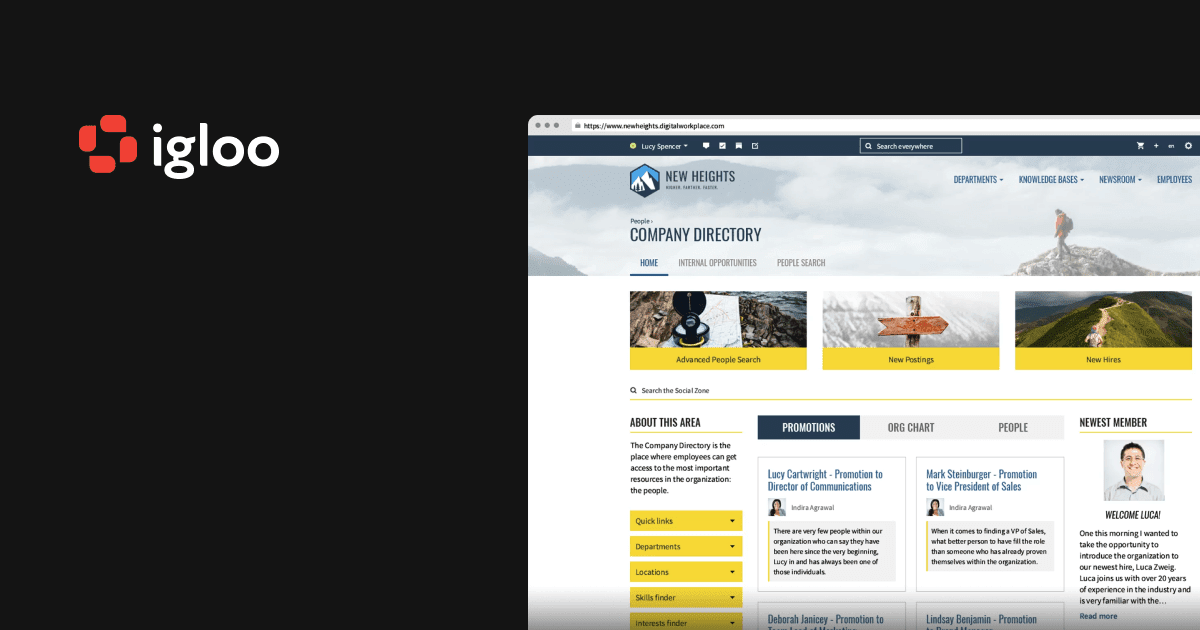
Igloo per Gartner Magic Quadrant
Igloo was recognized a Niche Player in the 2024 Gartner Magic Quadrant for IPS. The platform is positioned to deliver reliable customer support and cost-effective solutions, especially for “smaller organizations with budget constraints.” While it excels in benchmarking, it struggles to compete in innovation and lacks clear compliance with data protection standards compared to category leaders.
Igloo’s key strengths include:
- Highly rated for customer support and relationship building
- Cost-effective pricing for budget-conscious organizations
- Monthly insights program and benchmarking services for intranet maturity
With a unified search option for workers to find useful information from sources other than the intranet, Igloo “does not offer federated search”. The report noted that “some Igloo customers also highlighted issues around not having that immersive experience with its user interface.”
Unlike other software, Igloo falls short of demonstrating clear adherence to data protection and security standards. While it claims compliance with GDPR, HIPAA, CCPA, and ISO 27001, the report highlights that “these claims are not as evident as with other vendors in the market.”
Igloo per The Forrester Wave
Igloo has been named a Challenger in The Forrester Wave: Intranet Platforms, Q2 2024, which positions the platform in the bottom quadrant. Igloo excels in “content governance for driving approval or retirement actions, design capabilities for branding, and libraries of solution templates for onboarding or knowledge management.”
The report noted that Igloo should continue modernizing its platform “but must not lose focus on fundamentals.” The intranet platform has a strong track record of customer service and innovation, but “lags in support for writing assistants and other GenAI capabilities.” Other weaknesses include “survey and employee advocacy capabilities.”
Igloo per G2 Grid
The platform is in the bottom quadrant of G2, with user satisfaction ratings all below industry averages:
- Quality of support: 86%
- Ease of use: 85%
- Ease of doing business with: 84%
- Ease of administration: 82%
Igloo per IDC MarketScape
Igloo isn’t included in the IDC MarketScape: Worldwide Employee Experience for Integrated Employee Workspace 2025 Vendor Assessment.
Best for: Organizations with budget constraints that seek a platform offering diverse capabilities for their intranet.
8. Haiilo
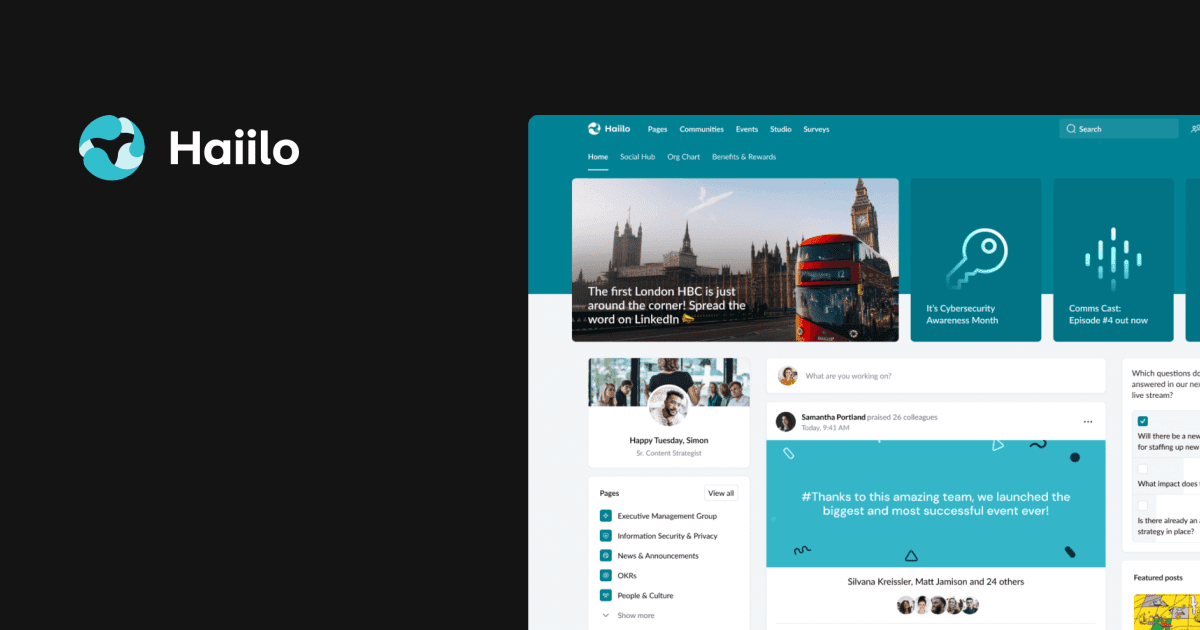
Haiilo per Gartner Magic Quadrant
Haiilo was named a Niche Player in the 2024 Gartner Magic Quadrant for IPS. Haillo’s modern intranet offers “modules for employee communications, mobile app, and analytics. Additional modules include employee advocacy and engagement surveys.” It typically appeals to organizations with a dedicated staff for internal communications, with IT’s support as a business enabler.
Key strengths include:
- Intuitive, simple UI for communicators
- Simple and economical pricing model
- Strong operational execution with high investment in design, engineering, and customer support
The Gartner report cautions that while customers may benefit from Haiilo’s intuitive, simple UI for communicators, it is more committed to “the internal employee communications and employee engagement use cases than other intranet use cases.” This may limit organizations looking for a platform that offers comprehensive intranet functionality, such as advanced knowledge management, workflow automation, or extensive collaboration tools.
Haiilo per The Forrester Wave
Haiilo was named a Contender in The Forrester Wave: Intranet Platforms, Q2 2024. Claiming the first to launch a GenAI writing assistant, AVA, Haiilo scored 3/5 based on AI/ML capabilities, while Simpplr scored 5/5. Based on current offerings, Haiilo received an overall score of 2.56 while Simpplr scored 3.58.
According to the Forrester Wave report: “[Users] showed high satisfaction with core capabilities such as its repository, reports, and communication tool, but expressed dissatisfaction with document search and ease of content.”
Haiilo per G2 Grid
Haiilo was named a Niche Player based on having a relatively lower satisfaction score and lower market presence compared to the rest of the vendors in the category.
- Quality of support: 92%
- Ease of use: 94%
- Ease of doing business with: 92%
- Ease of administration: 94%
Haiilo per IDC MarketScape
Haiilo was named a Major Player in the IDC MarketScape: Worldwide Employee Experience for Integrated Employee Workspaces 2025 Vendor Assessment.
Best for: Enterprises with 1,000 to 10,000 users in Europe and the US that want a combined platform for intranet and advocacy purposes.
9. MangoApps
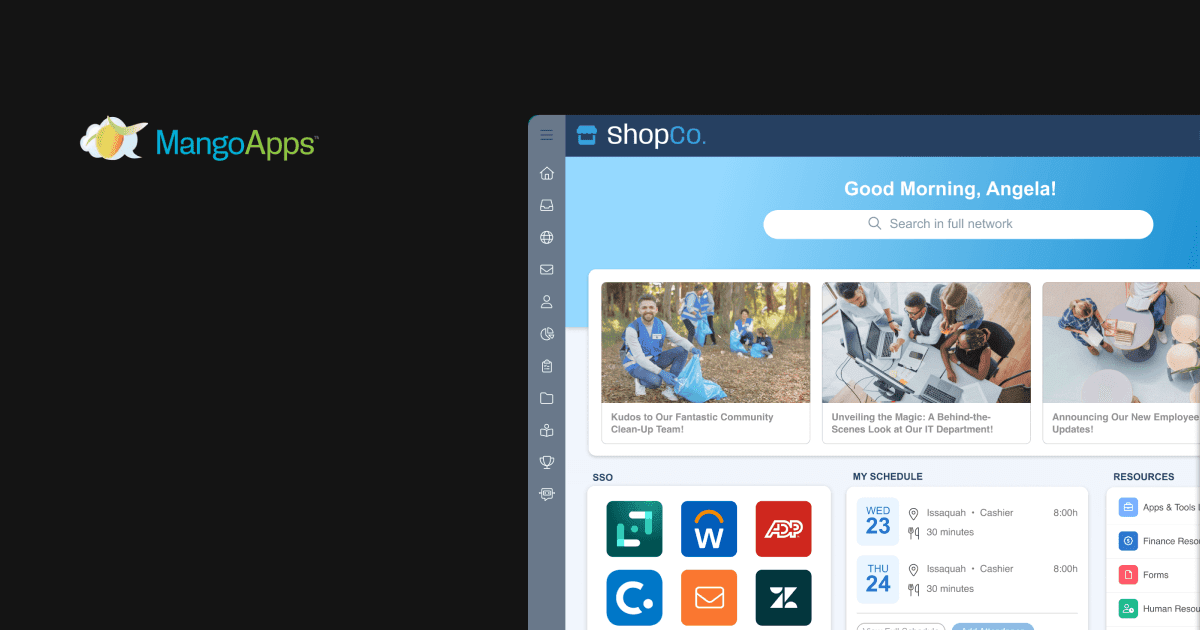
MangoApps per Gartner Magic Quadrant
MangoApps was named a Visionary in the 2024 Gartner Magic Quadrant for IPS report. It offers a modern intranet solution, a frontline employee app, and a set of operational efficiency solutions in its digital hub platform. The platform is a strong fit for modernizing highly complex and customized legacy intranet implementations, such as those built on Drupal, Liferay, IBM, or SharePoint Online. Customers appreciated its customer service and support.
Key strengths include:
- Seamless intranet implementations across CMS and digital EXPs
- Mobile-first capabilities to frontline workers
- A “client-centric” approach to services
However, Gartner cautions that MangoApps has limited analytics and reporting capabilities. For instance, it can be challenging to “compare the reach and engagement of their intranet content against competitors.”
MangoApps per The Forrester Wave
MangoApps was listed a Strong Performer in The Forrester Wave: Intranet Platforms, Q2 2024. MangoApps initially focused on small and medium-sized businesses but has moved upmarket to enterprises with a large segment of frontline workers. While it ranks closely to Simpplr in current offerings, its scores are slightly below in dashboards and reporting capabilities (3/5 for MangoApps compared to 5/5 for Simpplr).
According to the Forrester report, “customers are satisfied with MangoApps’ communication and design tools and a ‘client-centric’ approach to services. They are less satisfied with reporting.”
MangoApps per G2 Grid
MangoApps has been named a High Performer in the G2 Grid based on the strong satisfaction scores but low market presence compared to the rest of the category.
- Quality of support: 90%
- Ease of use: 87%
- Ease of doing business with: 92%
- Ease of administration: 87%
MangoApps per IDC MarketScape
MangoApps was recognized a Leader in the IDC MarketScape: Worldwide Employee Experience for Integrated Employee Workspace 2025 Vendor Assessment.
Best for: Large and midsize enterprises serving desked employees as their “IPS primarily targets office workers only.” Therefore, organizations with “significant frontline workers may prefer specialized vendors that more deeply focus on frontline workers’ operational and task-associated requirements.
10. Firstup
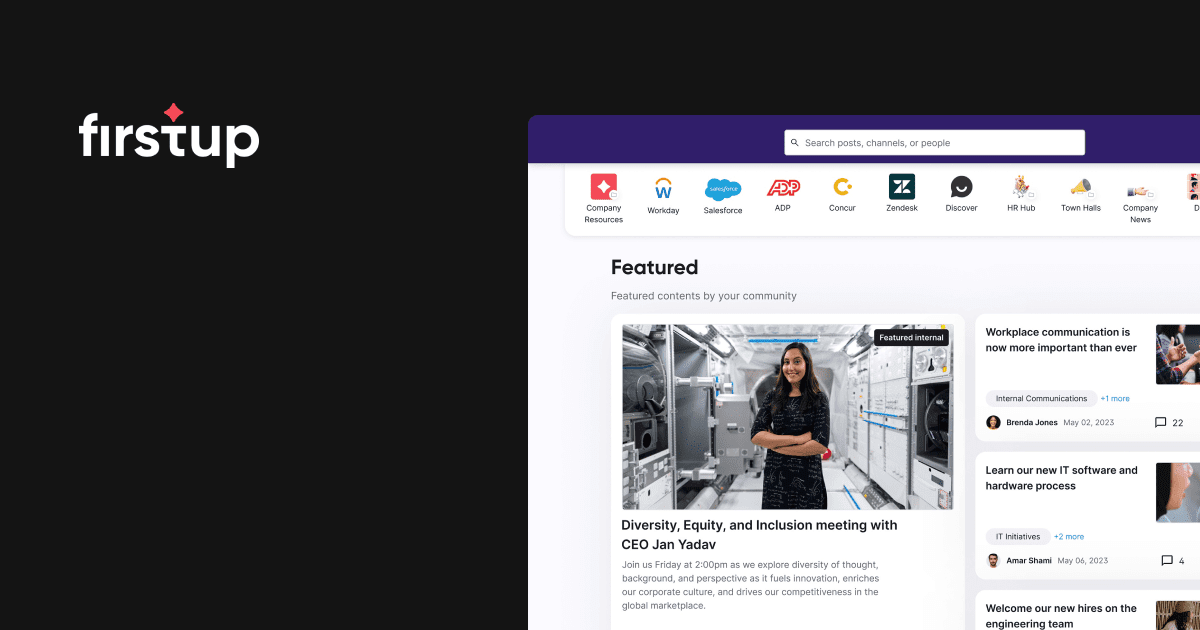
Firstup per Gartner Magic Quadrant
Firstup was a Leader in the 2024 Gartner Magic Quadrant for IPS report. Market responsiveness to industry trends continues to be a priority for Firstup’s offering strategy, which emphasizes improving governance, security, and data quality.
Key strengths include:
- Multichannel employee experiences compared to a traditional website
- Intelligent content delivery according to channel and preferences
- Features to improve governance, security, and data quality
Firstup offers its product and services across global regions, however, maintains its data and hosting options only in U.S. and Ireland. The pushes organizations “requiring greater control over data sovereignty or needing more diverse hosting options… to look at other vendors.”
The report further highlights that “Firstup may not be a good fit for environments with complex integration needs and where developers play a core role in shaping intranet capabilities.”
Firstup per The Forrester Wave
According to the Forrester Wave report, Firstup’s strengths include “calendaring tools for scheduling and coordination, preview tools for content creators, and flexible ways to define audiences.”
While Firstup is rated highly for its microapp integrations and mobile functionality, customers expressed dissatisfaction with the “lack of SMS support, inconsistencies in customer support, and complexity of multistep campaigns.” This indicates that organizations with complex communication workflows or those requiring multichannel messaging capabilities may find Firstup limiting.
Firstup per G2 reviews
Firstup isn’t included on the G2 Grid but received high praise for its simple and easy-to-use UI. The platform is built for engaging and connecting with workers across all levels of the organization.
“Love the ease of use with the platform. I’ve had the opportunity to allow my creativity to thrive with developing posts.” — Brianna Calloo, Internal Communications Specialist, 2024
While Firstup was appreciated for its simple interface, a customer expressed concern over analytics and slow page load, highlighting performance and flexibility issues that could impact user experience.
“Analytics can be delayed and overall the platform is fairly slow — pages take a long time to load. Also, you do not have the opportunity to leverage HTML to manipulate content, it’s all done through a design interface.” — Verified User in Hospital & Health Care, 2024
Firstup per IDC MarketScape
Firstup has been named a Major Player in the IDC MarketScape: Worldwide Employee Experience for Integrated Employee Workspace 2025 Vendor Assessment.
Best for: Retail and healthcare-focused organizations. Enterprises with complex integration needs or prefer a modern intranet platform may prefer more robust options.
Final verdict: Trade-offs and top picks
Best intranet platforms
The results are clear — Simpplr is the only intranet software consistently named a Leader across all four reports. If your organization needs a complete, industry-leading intranet solution, both experts and customers strongly recommend Simpplr’s platform.
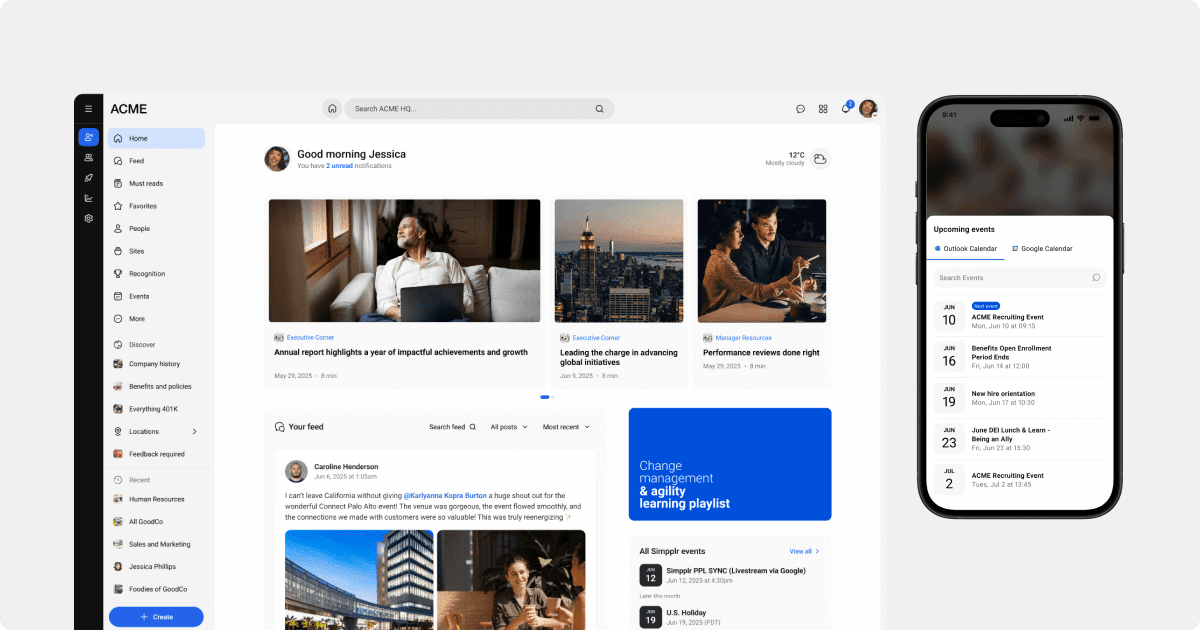
Trade-offs: What you should consider
Despite these results, not every business needs a complete intranet solution. For smaller businesses that simply need better communications, a messaging system like Slack might serve your purposes well as you grow. The following trade-offs are important to consider as you weigh your options.
Cost vs. value: How much does intranet software cost?
At the end of the day, every business decision comes down to ROI. What return or benefit will your organization see from its investment?
A Forrester study designed specifically to weigh the economic impact of implementing Simpplr calculated the following:
- A total three-year ROI of 283% for the composite organization
- $2.1 million in recaptured productivity from helping employees find resources faster
- $1.2 million in productivity gains from reducing the volume of emails
- 70% reduction in IT bandwidth used toward administering the intranet and supporting the internal comms team
Read the full Forrester economic impact report.
Business needs vs. platform features
To make sure you’re maximizing your ROI, start by evaluating your internal needs. If your organization is relatively small, a messaging platform or a product management tool might suffice over a fully integrated intranet solution. Midsize and enterprise organizations are more likely to see significant ROI from intranet software in both hard and soft returns.
Learning curve vs. intuitive use
One of the most important aspects of intranet platform implementation is that ROI follows adoption and engagement. If your intranet ROI is expected to flow from gains in efficiency and productivity, then your maximum gain requires widespread usage. The longer your intranet takes for employees to learn, the less likely it is that they’ll use it. So be sure to compare adoption rates across any platforms you consider.
See why industry leaders choose Simpplr as their modern intranet
While businesses scramble with fragmented tools and disconnected experiences, forward-thinking enterprises have already moved to the future of workplace technology: Simpplr: the #1 intranet for modern enterprises.
Simpplr goes beyond a traditional intranet by delivering a unified digital workplace that connects communication, knowledge, and services in one seamless hub. With built-in extensibility and integrations that adapt to evolving needs, Simpplr scales with your business — making it the intranet platform employees rely on today and in the future.
AI-powered enterprise search understands natural language and unifies results across all your apps. Advanced personalization delivers targeted content, and built-in analytics provide real-time insights that drive engagement.
What truly sets Simpplr apart is being the only intranet solution consistently recognized a Leader across all four major industry analyst reports. This recognition confirms Simpplr’s unmatched ability to deliver measurable business impact, combining innovation, scalability, and user experience to meet the evolving needs of modern enterprises.
See how Simpplr can transform your digital workplace and drive measurable business results. Request a demo today!
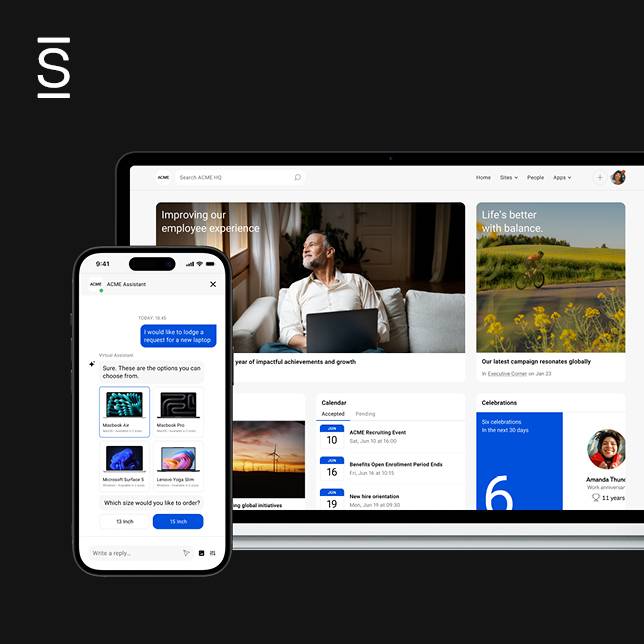
Watch a 5-minute demo
See how the Simpplr employee experience platform connects, engages and empowers your workforce.
- #1 Leader in the Gartner Magic Quadrant™
- 90%+ Employee adoption rate


